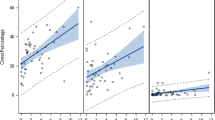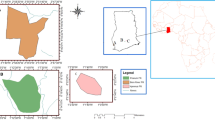Abstract
Most of the studies on invasive species are disproportionately focused on their ecological effects and more investigations are needed to understand the effects of invasive plants on rural livelihoods. This study assesses the effects of the invasion of Mikania micrantha—an invasive vine—on the livelihoods of the buffer zone community forest users of Chitwan National Park, Nepal. In this study, the invasive plants are categorized based on their life-form (woody and non-woody) and mode of introduction (accidental or deliberate). The focus is on accidentally transported non-woody species. A household survey revealed that the invasion disproportionately affects the livelihoods of forest-dependent households. In addition, the livelihood effects of invasive plants are particularly determined by the suitability of the invasive plants to produce locally important forest products.


Similar content being viewed by others
Notes
Katha is a unit of area, equal to approximately 66.89 m2.
Nepal is divided into three broad physiographic regions. The Terai region spreads from the Gangetic plains in the south to the foothills of the Siwaliks in the north, and is recognized as an area of fertile soil with relatively favourable access to communications and transportation.
Forest products collection time is expressed as time spends per trip to collect either fodder or fuelwood for a day requirement. This does not include the travel time between forest and dwelling.
The Bhari is the traditional unit of measurement for fuelwood and forage in rural areas, one bhari weighing about 25 kg.
References
Adamowicz W, Boxall P, Williams M, Louviere J (1998) Stated preference approaches for measuring passive use values: choice experiments and contingent valuation. Am J Agric Econ 80(1):64–75
Adhikari B, Di Falco S, Lovett JC (2004) Household characteristics and forest dependency: evidence from common property forest management in Nepal. Ecol Econ 48(2):245–257
Berzonsky MD (1992) Identity style and coping strategies. J Pers 60(4):771–788
Carver CS, Scheier MF, Weintraub JK (1989) Assessing coping strategies: a theoretically based approach. J Pers Soc Psychol 56(2):267–283
Central Bureau of Statistics (2001) Population Census (2001) Central bureau of statistics (CBS). Kathmandu, Nepal
Charles H, Dukes JS (2007) Izmpacts of invasive species on ecosystem services. In: Nentwig W (ed) Biological invasions, vol 193., Ecological studiesSpringer, Berlin, pp 217–237
D’Antonio CM, Kark S (2002) Impacts and extent of biotic invasions in terrestrial ecosystems. Trends Ecol Evol 17(5):202–204
de Neergaard A, Saarnak C, Hill T, Khanyile M, Berzosa AM, Birch-Thomsen T (2005) Australian wattle species in the Drakensberg region of South Africa—an invasive alien or a natural resource? Agric Syst 85(3):216–233
Department of National Park and Wildlife Conservation (2011) Annual report Shrawan 2067-Ashad 2068 (July 2010-June 2011). Department of National Parks and Wildlife Conservation (DNPWC), Kathmandu
Foster J, Sandberg LA (2004) Friends of Foe? Invasive species and public green space in Toronto. Geogr Rev 94(2):178–198
Frankenberger T (1992) Indicators and data collection methods for assessing household food security. In: Maxwell S, Frankenberger T (eds) Household food security: Concepts, indicators, measurements: a technical review. UNICEF, New York, pp 79–95
García-Llorente M, Martín-López B, Nunes P, González J, Alcorlo P, Montes C (2011) Analyzing the social factors that influence willingness to pay for invasive alien species management under two different strategies: eradication and prevention. Environ Manage 48(3):418–435
Ghisalberti EL (2000) Lantana camara L. (Verbenaceae). Fitoterapia 71(5):467–486
Government of Nepal (1996) Buffer zone management regulation 1996. Kathmandu, Nepal
Holm LG, Plucknett DL, Pancho JV, Herberger JP (1977) The world’s worst weeds; distribution and biology. Univ. Press of Hawaii, Honolulu
Holmes TP, Aukema JE, Holle BV, Liebhold A, Sills E (2009) Economic impacts of invasive species in Forests. Ann N Y Acad Sci 1162(1):18–38
Kaufmann JC (2004) Prickly pear cactus and pastoralism in Southwest Madagascar. Ethnology 43(4):345–361
Kosilla V (1988) The availability of crop residues in developing countries in relation to livestock populations.In: paper presented at the plant breeding and the nutritive value of crop residues, Addis Ababa, Ethiopia
Kuo YL, Chen TY, Lin CC (2002) Using a periodiccutting method and allelopathy to control the invasive vine, Mikania micrantha H. B. K. Taiwan J For Sci 17:171–181
Lowe S, Browne M, Boudjelas S, De Poorter M (2000) 100 of the world’s worst invasive alien species a selection from the global invasive species database. The Invasive Species Specialist Group, Auckland
McNeely JA, Mooney HA, Neville LE, Schei P, Waage JK (eds) (2001) A global strategy on invasive alien species. IUCN, Gland, Switzerland/Cambridge, UK
McWilliam A (2000) A plague on your house? Some impacts of Chromolaena odorata on Timorese livelihoods Human Ecology 28(3):451–469
Meyerson LA, Mooney HA (2007) Invasive alien species in an era of globalization. Front Ecol Environ 5(4):199–208
Moore PD (2000) Alien Invaders Nature 403:492–493
Mwangi E, Swallow B (2008) Prosopis juliflora invasion and rural livelihoods in the Lake Baringo area of Kenya. Conserv Soc 6(2):130–140
Pandit R, Bevilacqua E (2011) Forest users and environmental impacts of community forestry in the hills of Nepal. For Policy Econ 13(5):345–352
Pasiecznik N (1999) Prosopis- pest of providence, weed or wonder tree? Eur Trop For Res Netw Newslett 28:12–14
Poudel A, Baral HS, Ellison C, Subedi K, Thomas S, Murphy S (2005) Mikania micrantha weed invasion in Nepal: A summary report. In: The first national workshop for stakeholders,. Himalayan Nature, IUCN-Nepal and CAB International, Kathmandu, Nepal
Rai RK (2010) Plantation forests and ecosystem services: variations in ecosystem services from different platnations in the eastern himalayas. Lambert Academic Publishing, Saarbrücken
Rai RK, Scarborough H (2013) Economic value of mitigation of plant invaders in a subsistence economy: incorporating labour as a mode of payment. Environ Dev Econ 18(2):225–244
Rai RK, Sandilya M, Subedi R (2012a) Controlling Mikania micrantha HBK: how effective manual cutting is? J Ecol Field Biol 35(3):235–242
Rai RK, Scarborough H, Subedi N, Lamichhane B (2012b) Invasive plants – Do they devastate or diversify rural livelihoods? Rural farmers’ perception of three invasive plants in Nepal. J Nat Conserv 20(3):170–176
Sapkota L (2007) Ecology and management issues of Mikania micrantha in Chitwan national park, Nepal. Banko Janakari 17(2):27–39
Sapkota I, Oden PC (2008) Household characteristics and dependency on community forests in Terai of Nepal. Int J Soc For 1(2):253–282
Shackleton CM, McGarry D, Fourie S, Gambiza J, Shackleton SE, Fabricius C (2007) Assessing the effects of invasive alien species on rural livelihoods: case examples and a framework from South Africa. Human Ecology 35(1):113–127
Shackleton S, Kirby D, Gambiza J (2011) Invasive plants – friends or foes? Contribution of prickly pear (Opuntia ficus-indica) to livelihoods in Makana Municipality, Eastern Cape, South Africa. Dev South Africa 28(2):177–193
Siges T, Hartemink A, Hebinck P, Allen B (2005) the invasive shrub piper aduncum and rural livelihoods in the Finschhafen area of Papua New Guinea. Human Ecology 33(6):875–893
Siwakoti M (2007) Mikania weed: a challenge for conservationists. Our Nature 5:70–74
Stræde S, Treue T (2006) Beyond buffer zone protection: a comparative study of park and buffer zone products’ importance to villagers living inside Royal Chitwan National Park and to villagers living in its buffer zone. J Environ Manage 78(3):251–267
Sunderlin WD, Angelsen A, Belcher B, Burgers P, Nasi R, Santoso L, Wunder S (2005) Livelihoods, forests, and conservation in developing countries: an overview. World Dev 33(9):1383–1402
Swamy PS, Ramakrishnan PS (1987) Weed potential of Mikania micrantha H.B.K., and its control in fallows after shifting agriculture (Jhum) in North-East India. Agric Ecosyst Environ 18(3):195–204
Tiwari S, Adhikari B, Siwakoti M, Subedi K (2005) An inventory and assessment of invasive alien plant species in Nepal. IUCN The World Conservation Union, Kathmandu
Wilcove DS, Rothstein D, Dubow J, Phillips A, Losos E (1998) Quantifying threats to imperiled species in the United States. Bioscience 48(8):607–615
Willis M, Zerbe S, Kuo YL (2008) Distribution and ecological range of the Alien Plant Species Mikania micrantha Kunth (Asteraceae). Taiwan J Ecol Field Biol 31(4):277–290
World Bank (2011) The job crisis: Household and Government Responses to the Great Recession in Eastern Europe and Central Asia. World Bank, Washington
Zhang LY, Ye WH, Cao HL, Feng HL (2004) Mikania micrantha H. B. K. in China – an overview. Weed Res 44(1):42–49
Acknowledgments
This study is a part of the research project funded by South Asian Network for Development and Environmental Economics (SANDEE). The data presented, the statements made, and the views expressed are solely the responsibility of authors.
Author information
Authors and Affiliations
Corresponding author
Rights and permissions
About this article
Cite this article
Rai, R.K., Scarborough, H. Understanding the Effects of the Invasive Plants on Rural Forest-dependent Communities. Small-scale Forestry 14, 59–72 (2015). https://doi.org/10.1007/s11842-014-9273-7
Accepted:
Published:
Issue Date:
DOI: https://doi.org/10.1007/s11842-014-9273-7




